Deus Ex: Human Revolution preview
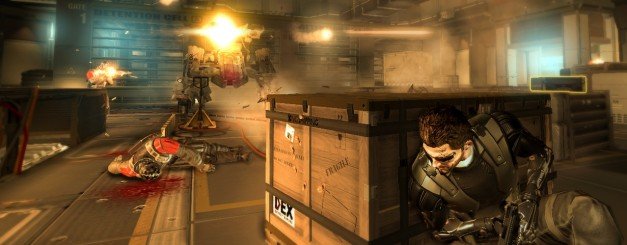
Deus Ex: Human Revolution has gained a slow groundswell of enthusiasm in our office. Tom keeps returning from viewings of the game, wide-eyed and grinning. “It's like Deus Ex! ”, he squeaks, before explaining the outcome of some open-ended mission. I'd slowly conditioned myself to expect a happily convoluted dialogue system, impressive characters, and a genuine feeling of choice from the game: exactly like Deus Ex. But, also exactly like Deus Ex, I hadn't expected to get on with the combat and stealth.
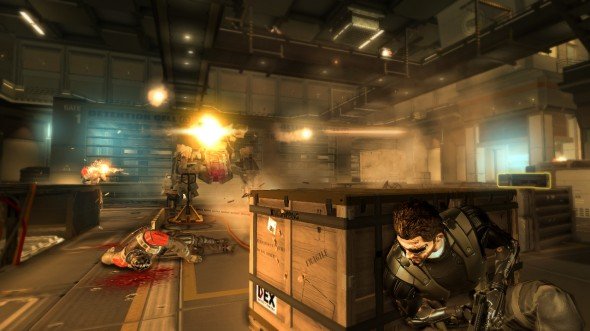
Jon Jacques-Belletête is infiltrating a warehouse. Jon is Human Revolution's art director, and his version of Adam Jensen is augmented up to the synthetic eyeballs. Augmentations give skills – from x-ray vision to the ability to punch clean through a wall and snap a man's neck in one fluid motion – and they're gained through 'praxis' points. Jon's Adam has more praxis than he's supposed to at this point in the game, letting him take a two pronged approach to the mission.
There's a trio of gang members relaxing in front of the warehouse. They're augmented too, but their exposed gold-and-chrome robo-arms lack the style of Adam's matte black guns. Jon should punch them for their gaudy fashion sense – and he could. But he doesn't. Instead, he talks to their leader, securing a weapon modification for his tranquiliser rifle. Purchasing the mod doesn't automatically weld it to your rifle. To do that, Jon needs to dip into his inventory. It's a comforting sight for Deus Ex devotees: it uses the same grid system the first game did, where each item takes up blocks of space depending on its physical size. Jon selects the weapon mod, clicks 'combine', and attaches it to his rifle. He pauses on the screen for a moment, resisting the urge to spend five minutes arranging his toys into neat little corners.
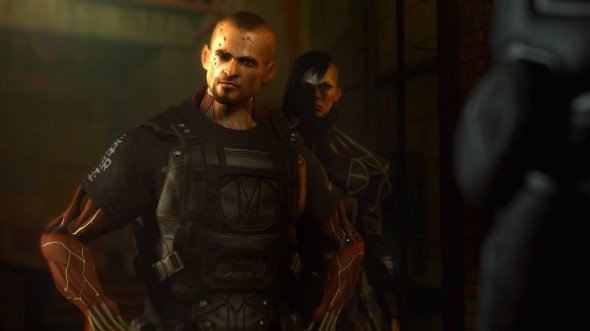
During Adam's batman-voiced questioning of the ganbangers, it becomes clear that the warehouse is the opposite of abandoned. Unbandoned? Jon's aiming for stealth during the first half of his playthrough, and after rounding the warehouse's first corner, hugs a low wall. Beyond lay two guards, chatting conspiratorially. Human Revolution flips to third person view when Adam's in cover (achieved by holding the right mouse button next to a solid object), a sweep up and out of Jensen's brain to a spot a few feet above his head that feels entirely natural. The introduction of a dedicated cover system seems means guards don't need to be the cataract-riddled myopia sufferers from the first game: if Jon had poked his head over the parapet as a grunt was looking his way, he'd be spotted and riddled with holes.
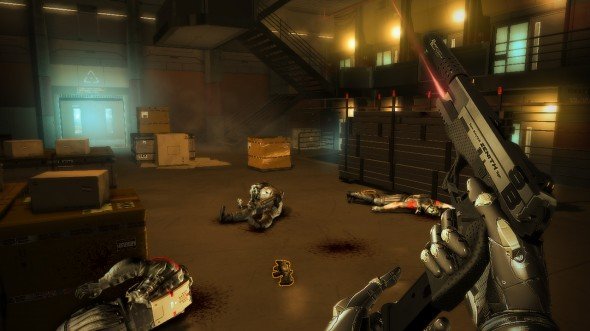
Fortunately, he doesn't, and he isn't. Jon waits out the conversation, and watches as the guards start their wider patrol. Their routes look semi-random, and – even worse for would-be super-spies – they regularly turn around mid-saunter to check their six. Jon takes a wide route to bypass any unfortunate spottings. Pressed against a low wall, he holds jump (space bar on the PC) to round a corner while still in cover. From there, he taps jump again, leaping behind a shipping container. He continues this pattern, waiting for guards to avert their eyes before rolling into the next chunk of cover, until he's near the door to the facility proper, with only a patch of bare ground between. Jon has a few options. He could wait until all guards in the area are studiously staring at a far wall and sprint for freedom. He could systematically take them all down with a melee attack – lethal or non-lethal depending on how long he holds the attack button – and saunter into the next area. He could even grab a nearby crate, hurl it a few feet, wait until the guards investigate the noise and crawl past them. Or, he could turn completely fucking invisible and ghost straight through. He sensibly chooses the latter option.
The cloak is another aug, and it gives a few sweet seconds of complete invisibility. Footsteps and other loud bangs would still give away Jon's position, but the guards are too far off to overhear. By the time his neuro-electric battery fails and his cloak fizzles off, he's through the door and into the facility.
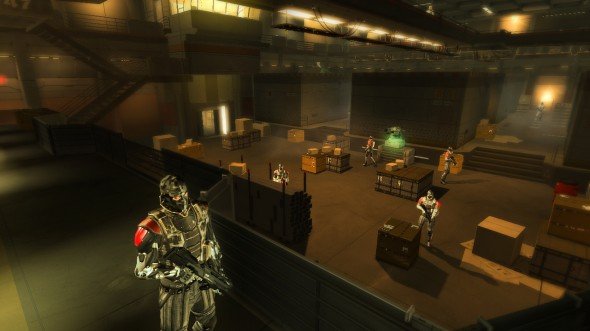
A few rooms and a spot of satisfying cover-hopping later, and Jon decides to change tack. It's become apparent the building is a headquarters for FEMA – the federal emergency management agency, and a familiar name to Deus Ex players. Jon finds himself on a balcony shared with a sniper, overlooking a group of guards and a set of cameras. Try to sneak past everyone, and detection looks likely. Instead, he busts out his tranquiliser rifle, replete with newly attached mod. The game's set in 2027, and the mod is suitably futuristic: Jon brings up his rifle's scope over a patrolling guard, and a small red reticule appears next to the centre crosshair, showing him where to aim to hit his walking target. However useful it is, the mod doesn't take the shot for you, and with the rifle's vague sway and the grunt's head-to-toe armour, it's a few wayward darts before the sniper slumps to the ground.
The biggest gaming news, reviews and hardware deals
Keep up to date with the most important stories and the best deals, as picked by the PC Gamer team.
From his vantage point, neutralising the other guards is a relatively simple affair: Jon sits Adam in cover and waits for guards to step beyond a camera's range, before launching a sedative-laden dart into their face. Unconscious enemies can't always be counted out of the fight – Jon explains that a guard who comes across a slumped friend will revive him before sounding the alarm – but tranquilised bodies can be dragged out of sight to reduce detection chances.
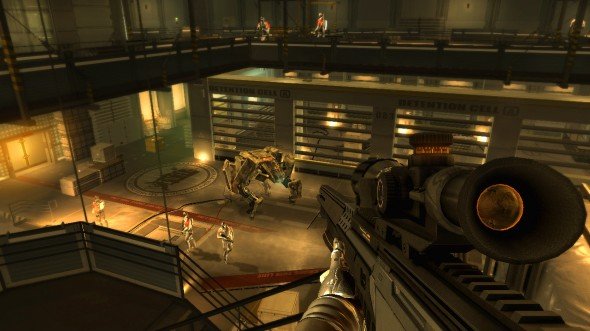
Once the room's residents are enjoying a restful, chemically induced sleep, Jon turns his attention to the cameras. EMP grenades knock them out for a short time, but the stun gun's electric charge does the same job. Jon fries the camera guarding his objective – an elevator – and ducks past.
The lift goes down, and during its short ride, Adam gets to see the operations of the 'abandoned' 'warehouse'. Through the darkened glass of the elevator door, Adam sees guards lining up, patrolling, and drilling. Most worryingly, he sees a hulking machine, tottering around on four legs. It's a boxguard, and it's more gun than robot. As the lift comes to rest on its destination floor, Jon surveys the scene: two grunts, and – oh shit – another boxguard. As soon as the doors open, Adam hurls himself forward and slams his back against a crate to avoid the droid's roving gaze.
The prospect of imminent perforation makes Jon change his approach again. He pulls out his combat rifle, and looses off a few shots at the nearby guard, knocking him down with a headshot. Human Revolution's cover system is closest to Rainbow Six: Vegas', and shooting seems to have the snap and kinetic power of that game's guns. Jon continues to fire, sending off three-second bursts before ducking back to reload. The men, despite their armour, are soft and squishy, and easily felled with concentrated fire. The droid is less forgiving. Staying in cover, Jon reprises his earlier acrobatics, and begins to roll into a new area. The droid loses track of his exact position, and keeps its guns trained on Adam's previous location. Meanwhile, Jon's extricated himself from immediate trouble, and found a new toy in the process. It's sleek, svelte, and it fires rockets.
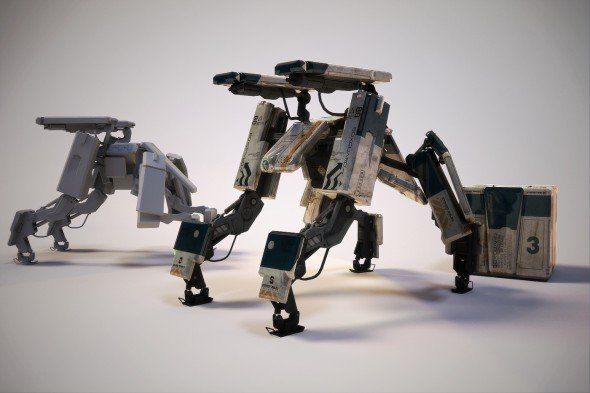
Ducking underneath a window, Jon shoulders his new rocket launcher. Hopping up, he's presented with the droid's broadside. He fires, and crouches back to safety. The rocket's damaged the droid – it's smoking, and I swear I see some sadness on its giant robot face – but it's still firing. Jon leads Adam to a new position, staying out of sight to get the droid's profile in the crosshairs again, and launches another rocket to finish the job.
For a 'proper' sequel to Deus Ex, I was prepared to forgive a lot. The first game is still my favourite of all time despite its wobbly action mechanics. Having seen Human Revolution's action - its solid gunplay and sensible, workable approach to stealth - I'm hopeful I won't have to forgive anything.

